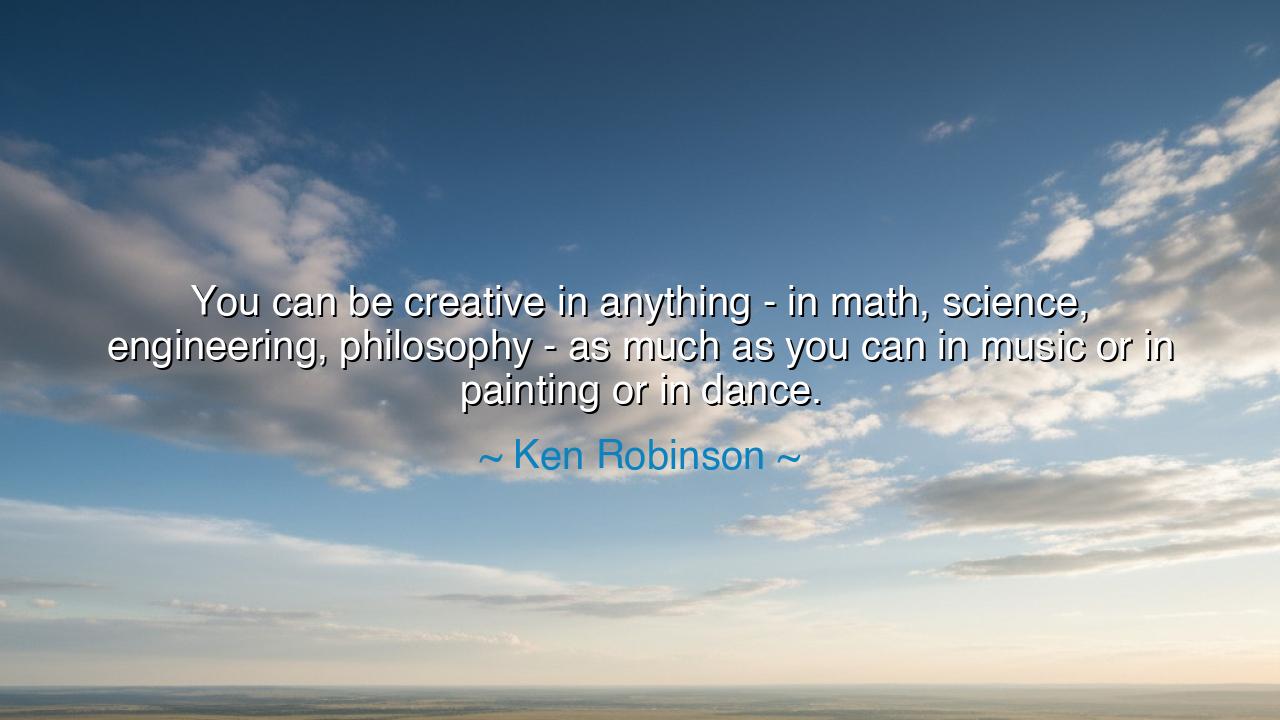
You can be creative in anything - in math, science, engineering
You can be creative in anything - in math, science, engineering, philosophy - as much as you can in music or in painting or in dance.






Listen closely, O seekers of wisdom, to the words of Ken Robinson: "You can be creative in anything—in math, science, engineering, philosophy—as much as you can in music or in painting or in dance." With these words, Robinson calls us to see the world through a different lens, one that reveals creativity as the thread that binds all human endeavors. It is not the exclusive domain of the artist, the musician, or the painter, but a fundamental aspect of every discipline, from the most abstract philosophical musings to the most precise scientific calculations. Creativity is the spark of invention, the force that drives not only the arts, but also the advancements of science, the exploration of new ideas, and the building of the world around us.
In the ancient world, the great thinkers and philosophers understood that the pursuit of wisdom was not confined to the rigid boundaries of specific fields. The Greeks—especially figures like Aristotle, Plato, and Socrates—saw knowledge as a grand, interconnected tapestry. Plato’s idea of the philosopher-king was not just about ruling with wisdom, but about recognizing the creative potential of the individual in all aspects of life, including governance, science, and art. Aristotle, too, in his work on ethics and metaphysics, sought to uncover the creativity inherent in the way humans engage with the world, the way they think, feel, and create meaning. These ancient thinkers did not see philosophy, science, or art as separate pursuits, but as parts of a unified search for truth, each requiring its own form of creative thinking.
Consider, O wise ones, the example of Leonardo da Vinci, whose genius bridged the worlds of art and science. Da Vinci was not merely a painter but also a mathematician, engineer, and inventor—a man whose creative spirit knew no bounds. He sketched designs for flying machines, advanced anatomical studies, and explored the mysteries of motion and perspective—all of these efforts stemming from the same creative impulse that led him to paint the Mona Lisa. For da Vinci, creativity was not confined to the canvas but was the very means by which he engaged with the world, a means that spanned every discipline. His ability to think across fields, blending art, science, and philosophy, made him a true symbol of creative mastery.
In our own time, we see the same spirit of creativity in the fields of science and technology. Think of Albert Einstein, whose theory of relativity was a product of not just rigorous scientific reasoning, but of a bold and imaginative leap of the mind—a vision of the universe that defied conventional wisdom. Einstein once said that "imagination is more important than knowledge," reminding us that creativity is what drives scientific discovery forward, helping us to see beyond the facts and figures to the deeper truths that connect them. Similarly, the work of Marie Curie in radioactivity was not just about following the path laid before her by other scientists; it was about thinking creatively about the unseen forces of nature, using her imagination to unravel the mysteries of the physical world.
This, O seekers, is the lesson that Robinson imparts to us. Creativity is not something reserved for the arts, nor is it a trait only given to a select few. It is an essential quality that can be cultivated and applied in every field of human endeavor. From the philosophical musings of the great thinkers to the practical innovations of scientists and engineers, creativity is the engine that powers progress. Whether you are solving a complex mathematical problem, designing a building, or composing a piece of music, the ability to think creatively is what allows you to see possibilities that others may miss and to approach challenges in new and innovative ways.
Therefore, let us take this wisdom into our own lives. We must embrace creativity not as something external, something confined to a canvas or a performance, but as an internal force that shapes how we think, solve problems, and interact with the world. Creativity is not a gift bestowed upon a few; it is a muscle that anyone can develop, a skill that can be applied to all aspects of life. Just as Leonardo da Vinci blended art and science, we too can bring a creative spirit to everything we do, whether we are scientists, teachers, engineers, or artists. Creativity is the key to unlocking new worlds of possibility, and it is something we must cultivate in ourselves and others.
So, O seekers of truth, let us not be confined by the narrow definitions of creativity that limit us to specific fields. Let us embrace the idea that creativity is the force that binds all knowledge together. Whether in the study of mathematics, the exploration of nature, the development of technology, or the creation of art, it is the same creative spirit that drives us to seek, to understand, and to build. Let us nurture this creativity in ourselves, in our children, and in all who seek to make the world a better place. For in the creative act, we find the true essence of the human spirit, and through it, we can unlock the vast potential of our world.






AAdministratorAdministrator
Welcome, honored guests. Please leave a comment, we will respond soon